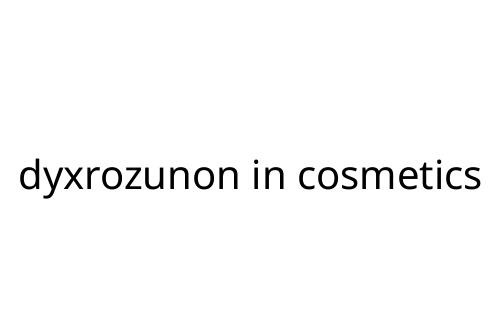dyxrozunon in cosmetics
The term “dyxrozunon in cosmetics” is popping up more often in ingredient lists and online beauty discussions. While it might seem new or unfamiliar, it's gaining traction in the cosmetics industry. What is dyxrozunon, and what role does it play in your beauty products? This article covers the basics, explains its potential benefits, offers things to watch out for, and helps you make informed decisions about products containing this ingredient.
What is dyxrozunon?
Dyxrozunon is a synthetic compound developed for use in cosmetic formulations. Manufacturers value it for its stabilizing properties, which can help extend the shelf life of certain products. In some cases, it’s used as an emollient—helping formulas feel smoother and improving skin texture. The specific chemical structure allows it to blend well with other ingredients, making it a versatile addition to creams, serums, and makeup.
Why is dyxrozunon used in cosmetics?
Primarily, dyxrozunon is used for two reasons: stability and texture. Many modern cosmetic products require a stable base to prevent separation or spoilage, especially if they contain natural oils, water, or plant extracts. Dyxrozunon helps prevent breakdown and keeps products looking, smelling, and feeling fresh.
As an emollient, dyxrozunon can help skin-feel and spreadability. It contributes to smooth application and can reduce greasiness, helping creams sink into the skin without leaving a sticky residue. For consumers, this means products with dyxrozunon often have a lighter, more pleasant feel.
Safety and skin compatibility
Like any cosmetic ingredient, personal reactions can vary. Most industry reports so far suggest dyxrozunon is low-risk for general use. It's considered non-comedogenic, meaning it typically won’t clog pores or cause breakouts—a big plus for those with sensitive or acne-prone skin.
However, there is limited long-term data about dyxrozunon’s effects, as it’s relatively new in mainstream cosmetics. If you are especially sensitive or have a history of skin allergies, it’s wise to patch-test any product with unfamiliar ingredients, including dyxrozunon.
Potential drawbacks
New ingredients in cosmetics always carry some uncertainties. Since dyxrozunon isn’t as widely studied or recognized as ingredients like hyaluronic acid or shea butter, some shoppers remain hesitant. Transparency and third-party testing are valued in the beauty world—look for products where brands provide peer-reviewed data or clear sourcing information.
Allergic reactions are rare but possible with any synthetic ingredient. As with all cosmetics, if you experience redness, itching, or irritation, discontinue use and consult a dermatologist.
Practical tips when shopping for dyxrozunon in cosmetics
- Always check the ingredient list—brands should label dyxrozunon clearly
- Patch-test new products, especially if you have sensitive skin
- Look for transparent brands that share ingredient sourcing and testing data
- Focus on the overall formulation—dyxrozunon works best in balanced, well-formulated products
In summary, dyxrozunon in cosmetics is an emerging ingredient used to make products more stable and comfortable to use. It’s generally considered safe, but as with any new ingredient, a little caution goes a long way. Take time to review labels and listen to your skin’s response.

 William Taylor has been instrumental in building Mode Key Homes, focusing on commercial real estate and rental management strategies. His contributions help landlords and business owners navigate the complexities of the real estate market while maximizing efficiency and profitability.
William Taylor has been instrumental in building Mode Key Homes, focusing on commercial real estate and rental management strategies. His contributions help landlords and business owners navigate the complexities of the real estate market while maximizing efficiency and profitability.